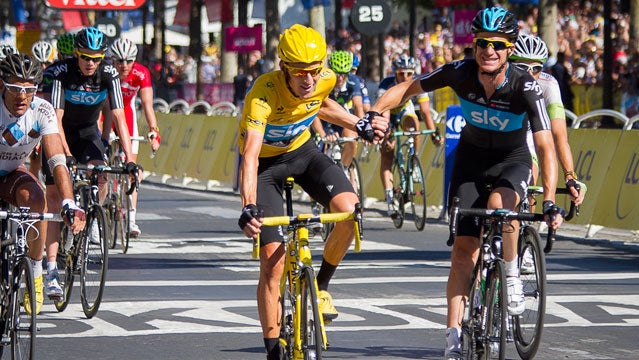This story is not about Lance Armstrong, but it starts with Lance Armstrong.
On July 27, 2005, Lance Armstrong rode down the Champs Elysees, the seven-time winner of the Tour de France. On the podium, a beautiful woman handed him a stuffed lion. He hugged his kids, also dressed in yellow. Kissed a rock star. Gave an impassioned—now, somewhat ironic—speech. (“I’m sorry you don’t believe.”)
On TV, 1.7 million Americans, including me, watched. We were winners, too. We set a record for Tour de France television viewership in the U.S. that day.
In the years that followed, viewership of the Tour de France waned and peaked. In 2006, Armstrong’s former teammate and eventual un-doer, Floyd Landis, won the Tour de France, and 310,000 average viewers per day tuned in, about half as many as during Lance’s farewell ride. Then Floyd got caught and was disqualified.
Amazingly, in spite of the doping scandal, even more Americans turned on the Tour the following year. An average of 343,000 people per day watched as Armstrong’s former team, Discovery Channel, took the Tour title, and American Levi Leipheimer, a recently admitted and retired doper, placed third overall.
In the year after that, 2008, a Spaniard named Carlos Sastre, widely known by fans as “Don Limpio,” or “Mr. Clean,” for his anti-doping ethos, launched a thrilling attack on the Alpe d’Huez and rode away to victory. But only 268,000 Americans saw what I considered one of the most exciting races in years.
Without an American challenger, it seemed like fan interest in the Tour was bottoming out. Then Lance announced he was coming back, and ratings doubled. In 2009 and 2010, roughly half a million people per day watched Armstrong battling his teammate, Alberto Contador, in the mountains (and the press). They saw him tear across the cobblestones in northern France, crash three times in one stage, and finally, announce he was finished. Ratings dropped, again. Then they climbed.
The first week of the 2012 Tour drew 29 percent more viewers, 409,000 per day, than in 2011. Last year, live weekend programming on NBC’s broadcast channel reached over 1,000,000 Americans. There was a U.S. racer in the mix, yes—rising star Tejay van Garderen placed fifth overall—but it also seemed the American bike racing audience had matured. We no longer needed announcer Phil Liggett to tell us the amount of energy saved by drafting (30 percent), or how an attack worked.
We got it, and we got more, with year-round live coverage of bike races like Paris Roubaix and the Tour of California on NBC Sports. We’d come along way from a single, two-hour CBS Sports Tour recap, accompanied by a .
Then, last winter, bike racing received some unexpected bad ratings. Lance sat down next to Oprah and admitted to using drugs, as 3.2 million people watched on TV. It made for , sure. But it also made many people wonder: Will the USADA investigation that took down Armstrong, and nearly every American who competed during his era, hamper the race’s upward ratings swing?
I don’t think so, and here’s why. A couple years ago, one of the Tour’s top advertisers, a small business with a quirky ad campaign, Road ID, conducted a survey to better understand the kind of people who tune into the Tour. Of the over 10,000 survey respondents, 50 percent were 40 to 49 years old, and 79 percent were between 30 and 64 years old. Eighty percent of those surveyed said they road biked regularly. Forty eight percent worked out four to five times a week.
These were middle-aged folks who also participated in the sport they were spectating. The demographic matches the growth of amateur bike racing in the U.S., which has nearly doubled over the last decade. I believe these mature, cycling savvy viewers get that the majority of racers sanctioned as a result of USADA’s Armstrong investigation will not be participating in this year’s Tour de France.
These viewers have likely heard that speeds over the Tour’s highest mountains have slowed dramatically, indicating a peloton almost absent of blood transfusions and EPO. They’ve adapted their expectations to performances that may be less dramatic, but are more believable. They like that the finishes are closer.
These viewers are excited about the new crop of young American pros like BMC’s Van Garderen, who dominated this year’s Tour of California, and Garmin-Sharp’s Andrew Talansky, who’s manager calls him the “Pit Bull,” ride his first Tour.
There may not be as many of these viewers as there were in 2005. But that’s okay, because this story is not about Lance Armstrong. And these viewers get that.


